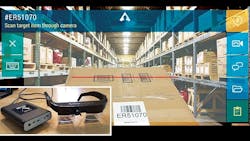Duke Augments Reality
Paper-based work management worked well for the utility industry for more than half a century. But with the increased productivity gains from digitization of the office environment, pressure gradually built to extend those efficiencies to the field. The limitations have always been the size and weight of the computer platform as well as the connectivity back to the central office.
Revolutions in physical layer technologies — cellular, WiMAX, WiFi and Bluetooth — along with the rate at which computer platforms have been miniaturized, have outpaced the rate of utility implementation. The ruggedized laptop that seemed so leading-edge 10 years ago now seems quaint in retrospect. Today, it is possible to carry in hand what would have been considered a supercomputer 10 years ago.
These advances in technology and communications have provided electric utility operations and maintenance personnel with new devices for running day-to-day operations and potentially reducing costs. However, quite a few emerging technologies are still in their infancy, and full-scale implementation is probably three to five years away. While many technologies are too immature to deploy, they are at a perfect level to investigate.
Enter Smart Glasses
Two technologies to investigate are smart glasses and virtual and augmented reality. Augmented reality technology overlays information in real time onto a view of the world through the use of mobile computing devices and graphics. Augmented reality goes beyond the mobile computing and geospatial information system (GIS) technologies utilities are using today. Augmented reality could be an effective way to aid the worker in performing activities such as inspecting assets, performing inventory transactions, maintaining substations, obtaining remote expert help, repairing equipment, retrieving documents, switching, tracking radiation exposure, and taking or reporting routine measurements.
Numerous companies have emerged to develop and use augmented reality in many different industries. These companies have expertise in augmented reality and wearable computing technologies as well as creative ways of displaying information that enhance productivity, but they have little to no understanding of electric utilities and their working environments. Several questions still need to be answered around the use of augmented reality for electric utility activities: Are there crew activities that would benefit from augmented reality and wearable technologies? Would augmented reality be more of a distraction than a help? Can the technology operate in an electric utility environment? What is the business case to justify a utility’s investment in augmented reality?
Pilot Projects
To address these questions, Duke Energy and the Electric Power Research Institute (EPRI) have launched a series of projects that place wearable technology and augmented reality in the middle of several common utility work flows. The Duke Energy projects are internal but also overlap with EPRI as part of its collaborative research model.
Duke Energy’s emerging technologies team started its first augmented reality project in the fall of 2014 to understand the current capabilities of the hardware and software offerings at the time and to investigate the possible range of use cases. At that time, a handful of vendors on the market were offering smart glasses. The team tested three use cases using four different technologies: Google Glass, Golden-I by Kopin, Vuzix MX100 platform by XOEye Technologies and Atheer Air.
The first pilot project tested the use of a live video and audio feed between field personnel and the operations office. The team learned three major lessons during this part of the pilot project. First, the IT security firewall blocked all audio and video content, so a separate network needed to be used. Second, given the glasses do not have a cell modem installed, the solution required use of either a hot spot through the phone or a Jetpack. The download and upload speeds were in the 0.2-second to 0.4-second range, and depending on the strength of the network, the speeds were faster from the location that was 300 miles (483 km) farther from the operations office, compared to the location that was 20 miles (32 km) away. Finally, the team found having live video and audio was more helpful than a phone call for field personnel who needed assistance.
Training App
The second pilot project was initiated with Atheer Air to develop an app for training. The use case for this project was a 10-step procedure from a generation plant. The use case is common for substation personnel who regularly change the settings on a SEL-351A relay to put it into maintenance mode and, upon completion, return it back to the normal operating mode.
The Atheer Air hardware provides an option for the user to pick the preferred app, outline the procedure step by step and mark each of the steps that have been completed, or view a picture or video to get specific directions to perform the task. At the end, the app enables the user to store the data and text, send an e-mail or make a phone call to notify a person of the completion time and any other information that needs to be relayed.
Overall Activities
The third pilot project was completed as part of EPRI’s augmented reality supplemental project. The objective of the Assessing Augmented Reality project was to identify utility activities that might benefit from augmented reality and then develop use cases collaboratively around priority activities. EPRI worked with member utilities, like Duke Energy, to measure performance characteristics of select activities prior to augmented reality application to establish benchmarks, and then measured performance characteristics of the same activities after augmented reality application to compare them to the established benchmarks.
Next, EPRI developed an augmented reality solution assessment framework and an approach to assess the effectiveness of different augmented reality solutions for various use cases. Finally, EPRI performed cost-benefit analysis on the identified activities to measure the value of adopting augmented reality. The EPRI project also measured the impact on the worker from an ergonomic perspective, analyzing the impact on muscles, bones, eye strain and situational awareness when augmented reality and wearables were introduced.
This use case was focused on creating an application that would aid a warehouse employee in performing inventory counting, one of the most commonly executed procedures in warehousing. The procedure includes obtaining and reviewing a list of bins and items that need to be counted, verifying the desired item has been located through barcode scanning (bin and item), and performing the count through verbal commands. The application automatically compares the counted value to the Maximo database value and, if it does not match, provides the user the option either to recount or to save and move to the next bin or item on the list.
More Work
The next iteration of the warehouse counting application is to develop internal navigation from bin to bin. Beacon technology is being considered for this application. WiFi devices also were considered, but from the standpoint of accuracy, beacons may provide the best solution.
Duke Energy is currently initiating a warehouse picking application pilot project. Currently, warehouse personnel use different ways of picking items from the shelves for different orders. The objective of the warehouse picking application is for the user to review the list of all orders, and for the user to be guided through the warehouse in the shortest and most efficient route to fulfil the order. When locating the item, confirmation would occur through barcode scanning and a notification would be sent to Maximo indicating the item has been picked.
In addition, Duke Energy will be working with one of the universities to build a complete suite of apps on the Atheer Air platform that will cover substation inspections of transformers, breakers, batteries and other assets. Based on feedback from the end users, this might be expanded to cover not only the asset inspection but also asset repair application.
Future Efforts
Duke Energy’s plans include the development of a storm restoration application. The objective of this application is to provide the field user with images and data about the assets that were previously in operation before being taken down during a storm. This would be especially useful to non-native repair crews being deployed for restoration work. Taking a picture of the affected area, tying it to a GPS coordinate and having a connection to the GIS should enable the glasses to display the original asset location and make it easier for field personnel to visualize the work that needs to be performed.
An additional benefit would be the automatic generation of a bill-of-materials the supply chain business unit could use to aggregate purchasing needs for the warehouse replenishment of storm restoration needs.
Moving forward, Duke Energy and EPRI will collaborate with other utilities to investigate the capabilities of virtual and augmented reality further. Several use cases are being developed currently, such as warehouse picking, substation equipment maintenance protocol and, ultimately, smart glasses being able to see the area affected by a storm, having a connection to the GIS and overlaying images of assets taken down by the storm, like wires, poles, transformers and insulators. Finally, the glasses and augmented reality app would be capable of issuing a request to the warehouse for the material that needs to be used to bring the system back up.
The preferred option for moving forward will be a function of the cost of ownership, change management support, the ability to incorporate multiple integrated data streams, and most importantly, the ability of personnel to do their job without the equipment being a hindrance or having a negative effect on implementation.
Aleksandar Vukojević is the manager of emerging technologies office at Duke Energy. His duties involve developing, installing, testing and evaluating new technologies. Vukojević holds a bachelor’s degree in applied mathematics from Kennesaw State University, a BSEE and MSEE degree from the Georgia Institute of Technology, and a MBA degree in corporate finance from Georgia State University. Currently, Vukojević is pursuing a Ph.D. degree in electrical engineering at the University of North Carolina at Charlotte.
Chet Johnson is the lead enterprise asset management strategic business consultant for finance, fleet and supply chain business units across Duke Energy. His duties involve consulting with internal business units, worldwide peer users and IBM to advance the use of the IBM EAM Maximo product suite and associated products and technologies.
John J. Simmins is a technical executive at the Electric Power Research institute, where he manages the information and communications technology for distribution project set. His current research focuses on integrating back-office applications with devices and personnel in the field. Simmins also leads EPRI efforts in the use of augmented reality, social media, data analytics and visualization to improve grid resilience. Prior to joining EPRI, Simmins was with Southern Maryland Electric Cooperative, where he managed the engineering and operations applications. He holds a bachelor’s degree and a Ph.D. degree in ceramic science from Alfred University.



